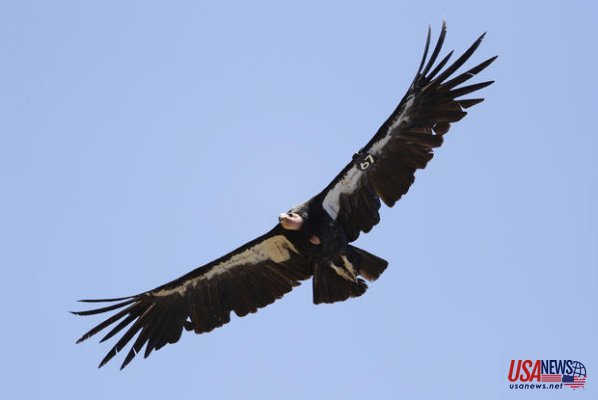According to a Thursday study, endangered California condors may have "virgin births." The San Diego Zoo Wildlife Alliance has confirmed that genetic testing proved that the two male chicks born in 2001 and 2009 from unfertilized egg eggs was related to their mothers. Both were not related to males.
The study was published on Thursday in the Journal of Heredity. This is the first time that California condors have been reported to reproduce sexually. However, parthenogenesis can also occur in other species from honey bees and sharks to Komodo dragons.
It is rare for birds to have this effect because they don't have males. Each mother condor had previously bred 34 chicks with males and was housed with a fertile man at the time of parthenogenesis.
This June 21, 2017 file photo shows a California condor flying in the Ventana Wilderness east from Big Sur, Calif. MARCIO JOSE SANCHEZ/AP
Researchers believe that this is the first instance of sexual reproduction in an avian species. The female was able to find a mate.
Oliver Ryder, co-author of the study and director for conservation genetics at the San Diego Zoo Wildlife Alliance, said that "these findings now raise questions as to whether this might occur undetected among other species."
This non-profit alliance manages the San Diego Zoo Safari Park, and was involved in California condor breeding programs that saved the giant vultures from near-extinction.
California condors, which have a wingspan of 10 feet, are the largest flying birds in North America. Once they were found all over the West Coast. Only 22 of them survived the 1980s, when the U.S. government took them and put them in zoos to be kept for captive breeding. Around 160 animals were raised at San Diego Zoo Safari Park.
More than 500 California condors are currently in existence, with more than 300 of them being released into the wild in California and Arizona.
Asexual reproduction was first discovered years ago through extensive testing of genetic material from condors (both living and deceased) collected over many decades in breeding programs and in nature.
The study found that none of the 467 California condor males studied in parentage analysis qualified for the role as potential sires.
California condors can live for up to 60 years. However, both of the males died from illness. The one who died was less than two years old, while the other lived for less than eight years.
How hunters can help the California condor comeback
Chris Parish, director of global conservation for the Peregrine Fund , told CBS News earlier this season that 54% condor deaths are due to lead poisoning
Lead is a neurotoxin that can be deadly. It's also the main ingredient in most ammunition. Birds are dying due to bullets. They aren't being shot at by them, they're actually eating lead.
Parish stated that they are not allowed to "scavenge wildlife that is obligates," such as the condor.
Hunting deer often leaves behind some remains after they kill it. They may have accidentally left behind small pieces of lead that end up in condors as they pass by to enjoy a meal.
Parish stated that "some of those small fragments that strip off those bullets we have used for 100 years can be poisonous to wildlife."
Parish is on a mission: to persuade hunters to hunt with non lead ammunition like copper bullets. He has been demonstrating across the country. He is familiar with the world: "I'm a redneck hunterbiologist and these hunters are my people."












